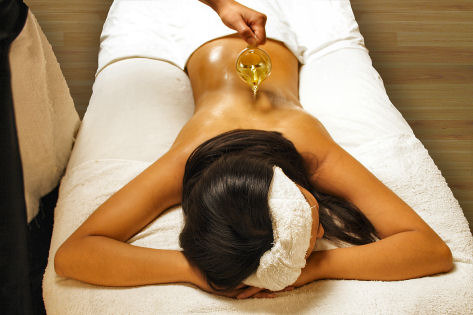Ayurvedic massage (Abhyanga) vs Common massage
Ayurvedic massage is called Abhyanga.
Ayurvedic massage is one of the Bahiparimarjana Chikitsa, according to Ayurveda (external oleation therapy). Snehana Karma, according to Charaka, is the technique that creates Snehana (unctuousness), Kledana (fluidity), Mriduta (softness), and Snigdhata (moistness) in the body (oleation therapy)
It has a wide spectrum of health advantages, including disease prevention, rejuvenation, and cure. Because of its relevance, Abhyanga has become an important aspect of the Dinacharya (daily routine) and in the treatment of Vatavyadhis, Shula, Stambha, and other ailments. Because the skin is the body’s largest organ, abhyanga aids in the transdermal absorption of the Snehadravyas. According to modern pharmacology, absorption via the skin can be improved by suspending the drug in a liquid medium and rubbing it on the skin.
This has an effect on the body’s soft tissue, which relaxes the soft tissues and soothes pain. It has the ability to stimulate the lymphatic system and thereby removes the bodily toxins generated in the muscles which results into relaxation of the muscular tissue. Ayurvedic massage is not a simple procedure of application of oil all over the body. It is a maneuver that helps in maintaining the excellence of tissues.
Types of Abhyanga
Based on the application methods
– Samvahana– It means application or just smearing of oil over the body parts and also useful in newborn care.
– Parisheka– It means sprinkling of oil, used immediately after birth to relieve the stress of labour while passing through birth canal and alleviate the increased Vata Dosha. It is included in Jatamatra Paricharya.
– Abhyanga– It means application of oil on whole body or body parts with optimum pressure and in particular directions and applying the strokes. It is not directly quoted in protocol
– Mardana– Application of oil or dry powder over body or body parts with enough pressure along with squeezing of body muscles in appropriate manner.
Indications of Abhyanga
– As a Dinacharya procedure to maintain the health.
– Shiro Abhyanga- Dry scalp, itching (Arunshika)
– Taila Abhyanga- Bala, Vriddha, Krisha persons
– Diseases of hair- Darunaka, Khalitya, Palitya etc.
Direction of Ayurvedic Massage
Generally, to be done in Anuloma Gati (in the same direction to those of the hair)
According to Dosha predominance-
- Vata Dosha- Anuloma Gati
- Kapha Dosha- Pratiloma Gati
- Pitta Dosha- Alternate Anulona Gati and Pratiloma Gati
Selection of Oil for Abhyanga
According to Vagbhata, sesame oil possesses the properties like penetrating deep into the tissues, and spreading throughout the body fast, capable of entering into even minute pores, hot in potency, not increasing Kapha. According to Dalhana, sesame oil penetrates into the deepest level of tissues in only 5-10 minutes.
Difference between Abhyanga and massage
Normal massage is not the daily routine procedure like Ayurvedic massage, and be contraindicated in inflammatory conditions, fractures, sprains and strains, while Abhyanga is mainly concerned with the digestion and Kapha Dosha predominance in body of individual.
Massage
- Can’t be used as a prior therapy for Panchakarma
- It may not be taken as part of the daily routine
- It is not a main treatment; it is always supplementary
